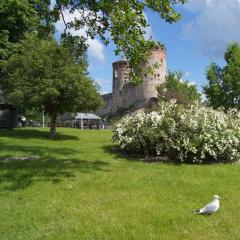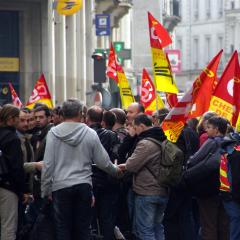Depot near Moscow how to get there. Podmoskovnaya (station). Travel by car
30 photos, total weight 17.5 MB
As part of the construction of the Riga Railway (formerly Vindava Railway), a
Podmoskovnaya station. When traffic opened on the road, a fan-type locomotive depot with a turntable was also built. Trains departed from the station until the opening of the Vindavsky (now Rizhsky) station in September 1901. Before the opening of the Krasny Baltiets platform in 1945, passenger traffic was carried out through the station. In the 1940s, the station was the largest marshalling station of the Moscow railway junction. Now the passenger line runs north of Podmoskovnaya, which is still one of the largest freight hubs in Moscow. The depot is located between the Sokol metro station and the Timiryazevsky forest park. Now this is the only Moscow depot that maintains the infrastructure for preventive maintenance of steam locomotives. The depot serves both local steam locomotives (running daily from Rizhsky Station as part of the excursion program of the Russian Railways Museum) and steam locomotives of the Shcherbinsky Ring. It is here that visitors are brought as part of the “Retro Train” excursion, departing from the Rizhsky Station.
In 2001, the following sign was erected:
The station has preserved a wooden station building, a complex of depot buildings: a water tower, a fan-type locomotive depot building with a turntable, an administrative building (depot office) and a house for the staff servicing the tower. All buildings were built in 1901 in the Art Nouveau style and are a single architectural ensemble - the last (according to Internet sources) to survive on the Moscow-Vindava Railway line.
First, let's take a walk to the fan. Previously there were 13 parking spaces, but later some of them were turned into premises. Currently there is space for 9 or 10 steam locomotives/locomotives:
All entrances are made of brick, as is the front part of the fan. The main hangar is made of reinforced concrete.
Despite the small apparent size of the fan, it is very spacious inside - the width of the fan is 30 metres, the height is up to 8-9m:
The height of this L-type locomotive is 5 meters!
The hangars also house disassembled and restored steam locomotives:
The gate leaves may have been hanging here for more than 110 years and have seen 5 generations of installers :)
In general, it’s quite cool to walk along such a fan; you don’t even suspect what you’ll see beyond the passage to the next section. Each section has 5 locomotive seats:
And here it’s empty, he’s probably gone to carry passengers :)
We met the work plan for 3 months ahead:
Despite the loyalty of the local fitters, it was still decided not to catch their eye with a camera, so from there we soon retreated to the street. More photos of the entrances to the hangars:
Along the fan's path, the locomotives are distributed by a turntable, which is naturally still in operation:
The wooden booth of the circle manager has still been preserved:
The electrification of the circle, on horseback, is very interesting:
The railway tracks run from the station in three directions - from the western part of the station along Konstantin Tsarev Street on the MK Moscow Railway, to the Serebryany Bor station, as well as towards Rzhev and the Rizhsky station (in the Rizhsky direction). And the roads leaving the depot are generally creepy:
When leaving, there is another rare thing - a hydraulic column for filling locomotives with water:
On the territory of the depot there is another hangar for 2 locomotive spaces. As I understand it, this is the main workshop where short-term minor repairs, lubrication and inspection of machine parts are carried out. At the time of our visit there were two steam locomotive L early 50s of the 20th century. The height of these colossuses is 4.99 m, and the working weight is as much as 102 tons!!!
This is what the entrance to the second hangar looks like from afar:
There are a couple more rusty locomotives at the entrance:
There are also monuments on the territory of the Moscow region. For example, the ubiquitous memorial plaque in memory of those killed during the Second World War:
Old water tower, built in 1901. I think now it is not used for its intended purpose.
The “modern” replacement for steam locomotives is the ChME3 locomotive from 1989:
In general, we accidentally wandered into the depot; there was no such purpose. Just making our way through Timiryazevsky Park, we saw a smoking steam locomotive on the Riga direction between the Krasny Baltiya and Grazhdanskaya platforms and decided to try to go look at the steam locomotives, just like that :)
According to Wikipedia, on November 18, 2008, Moscow Government Decree No. 1070-PP “On the General Scheme for the Development of the Moscow Railway Hub” was adopted. According to this resolution, Podmoskovnaya station will be liquidated and a residential area will be built in its place, which I hope will not happen!
At the end of July, among other announcements, I came across the arrival of the head of Russian Railways for the opening of a museum and industrial complex based on the Podmoskovnaya depot. Unfortunately, accreditation was already closed, so I went there in my free time from work with a child who really loves trains.
So, let's talk about the main thing right away - DO NOT COME here on weekdays. The museum is open only on weekends from 10 to 16. Since the museum does not even have its own website, you can only find out about it from this post, or from a piece of paper on the closed gate.

The station and its locomotive depot were built in 1901. A fan-type locomotive depot with a turntable and a water pumping station were also built there. In 1938, a connecting track was built at the station with the Sokol electric depot under construction, through which the Moscow Metro began to receive cars from the plant.

Roundabout depot at Podmoskovnaya station. 1900-1930

At the entrance I was greeted by a polite security guard. He didn’t take any money for the tickets, which surprised me, but then it became clear why. He took me to the station building. In fact, the station building is located in a different location, but it was decided to make a museum in this utility room so that all the objects were in one place.

There is a waiting room, a ticket office...

... luggage compartment



There is also a buffet and a mock-up of an omnibus where you can sit, but that’s basically all. But it’s clear why they didn’t take money for entry. In the near future, a cafe will open in a separate building and excursions to the depot itself will begin. In the meantime, you can look at it from the outside


If you're lucky, you'll find a working steam locomotive nearby.

Also, at the end of July, the most modern multi-unit depot in Russia, Podmoskovnaya, was opened at the station, where passenger electric trains that will run along the Small Ring of the Moscow Railway, as well as Lastochka and Sapsan trains, are serviced. You can walk from the museum to the depot; no one is rushing you. Through the glass I had a chance to admire the half-disassembled Sapsan
(G) (O) (I) 55.814089 , 37.527858|
Podmoskovnaya station Riga direction |
|
| Moscow Railway | |
| Opening date: | |
|---|---|
| Number of platforms: | |
| Exit to: | |
| Transfer to: | |
| Distance to Moscow: | |
| Station code: | |
Podmoskovnaya- junction railway station of the Riga direction of the Moscow Railway in Moscow, located in the Sokol district.
Station history
The station was built in 1901 as part of the construction of the Vindava Railway (now the Riga direction of the Moscow Railway). By the opening of traffic on the road, a fan-type locomotive depot with a turntable and a water pumping station with a coal warehouse for equipping steam locomotives were built. Trains departed from this station until the opening of the Vindavsky station in September 1901; the first train departed on July 2, 1901.
In 1938, a connecting track was built at the station with the Sokol electric depot under construction, through which the Moscow Metro began to receive cars from the plant.
Before the opening of the Krasny Baltiets platform in 1945, passenger traffic was carried out through the station. Since about the same year, you can get to the Krasny Baltiets platform via a pedestrian bridge passing over the station tracks.
In the 1940s, the station was the largest marshalling station of the Moscow railway junction.
Enterprises and station infrastructure
Infrastructure
The railway tracks run from the station in three directions: from the western neck of the station along Konstantin Tsarev Street on the Moscow Railway MK to the Serebryany Bor station, as well as towards Rzhev and the Rizhsky station (along the Riga direction of the Moscow Railway). The boundaries of the Podmoskovnaya station include the Krasny Baltiets, Leningradskaya and Pokrovskoye-Streshnevo platforms, since the first two are located in close proximity, and on the Pokrovskoye-Streshnevo platform until recently there was a track development related to the Podmoskovnaya station. The track development has more than 30 tracks, not counting the tracks related to the depot.
At the Krasny Baltiets platform on Kosmonavta Volkov Street there are stops for bus No. 780 and trolleybus No. 57. From the station you can exit to Ambulatorny Lane, 2nd Ambulatorny Avenue, 3rd Baltiysky Lane. and st. Cosmonaut Volkov. The nearest metro stations are Sokol and Voikovskaya.
Station enterprises
At the station there is a workshop of the PM-18 locomotive depot named after Ilyich, and until the 2000s there was a locomotive depot PM-16 Podmoskovnaya. The rolling stock is diesel locomotives ChME2 and ChME3. A recovery train is also based at the station. The loading terminal is working.
Historical monuments
The station has preserved a wooden station building (Kosmonavta Volkova St., 10, building 2), as well as a complex of depot buildings: a water tower, a fan-type locomotive depot building with a turntable, an administrative building (depot office) and a staff house, serving the tower. All buildings were built in 1901 in the Art Nouveau style and are a single architectural ensemble - the last one to survive on the Moscow-Vindava Railway line; all its other stations were partially or completely destroyed during the Great Patriotic War. Before the opening of the Vindavsky (modern Rizhsky) station on September 11, 1901, Podmoskovnaya served as the terminal station of the Moscow-Vindavsky Railway, and its station served as one of the capital's stations in the period from July to September 1901. Since December 2008, the buildings of Podmoskovnaya have been historical and architectural monuments of regional significance and are under state protection. Since 2006, Podmoskovnaya has been a tourist attraction - regular tours of the station and depot are held for everyone. Every Sunday, a locomotive-powered retro train departs from Rizhsky Station to Podmoskovnaya. During the tour, you can see the historical buildings of the station, as well as watch the locomotive turn around on the turntable and fill the locomotive with water.
Movement around the station
Driving directions
Trains move through the station in three directions:
- To the East
- To the west - to the MK MZD.
- To the northwest - to Manikhino-1, Rzhev, Velikiye Luki, Riga.
Train movement
Passenger trains (3 pairs per day) travel through the station park without stops and only in the Riga direction of the Moscow Railway, as do commuter trains (about 75 pairs per day) stopping on the platforms
#locomotive depot near Moscow
The museum is not yet accepting Olympiad participants
Wednesday - Saturday from 10-00 to 16-45; Sunday from 10-00 to 16-30. The ticket office closes at 16-00
Ticket price: Adult visitors - 150 rubles. Pensioners, students, schoolchildren 100 rub. Children under 7 years old 60 rub. Free admission - the third Wednesday of the month (only for Olympic participants). The cost of the excursion (application strictly by calling the museum) is 1,500 rubles. (group up to 20 people). When visiting the museum on an excursion, purchase a tour voucher and an entrance ticket at the museum ticket office. The excursion package is valid only with an entrance ticket. All excursion services are paid at the cash desk regardless of the day of visit.
Museum opening hours in March: Registration for a free visit (third Wednesday of the month) occurs through the form available at the link. Attention! Participants in the Olympiad are schoolchildren (children) who are registered on the Olympiad website. Accompanying persons (adults) pay entrance tickets according to the price list. On the free day for participants, entry is strictly according to the Olympiad registration list. Payment at the ticket office can only be made in cash. The cost of the excursion (application strictly by calling the museum) is 1,500 rubles (group up to 20 people). Travel by car: Travel by public transport: Bringing and consuming your own food on the premises is PROHIBITED. |
Historical site "Locomotive Depot" at the station "Podmoskovnaya" At the historical site of the locomotive depot you will see the premises and building of the station, which recreates the atmosphere and decor of the early twentieth century. In the station building there is an old ticket office and telegraph, you will visit the waiting rooms for various classes of the public, and, of course, look into the buffet, where you can see how visitors who were waiting for the arrival or departure of the train were previously served. There is a very interesting interactive mirror in the waiting room. If you look into it, you can see yourself in a crowd of passengers rushing about their business. In addition, you can go (virtual tour) on a stagecoach around Moscow at the beginning of the 20th century, from the village of Vsekhsvyatskoye to Red Square. There is a water tower on the museum grounds. You will be able to visit the room where you will be shown interactive exhibits and the process of refueling and filling a steam locomotive with water. And that's not all... You will visit the office of the head of the railway station, where you will see a work office. You will feel the atmosphere of antiquity in the service apartment of a railway employee of the early twentieth century. At the depot you can see employees working in the machine shop making a part to repair a steam locomotive. In the hall there is a steam locomotive of the Er 766-24 series, an unusual cross-section, where you can find out the structure of ancient steam locomotives. The exhibition ends with a turning circle of the locomotive depot. Where locomotives stand with smoke and steam waiting to set off.


